Prognostic factors for disease-free survival in postoperative patients with hepatocellular carcinoma and construction of a nomogram model
Pan-Quan Luo, Zheng-Hui Ye, Li-Xiang Zhang, En-Dong Song, Zhi-Jian Wei, A-Man Xu, Zhen Lu
Pan-Quan Luo, Zheng-Hui Ye, Li-Xiang Zhang, En-Dong Song, Zhi-Jian Wei, A-Man Xu,Department of General Surgery, The First Affiliated Hospital of Anhui Medical University,Hefei 230031, Anhui Province, China
Zhen Lu, Department of General Surgery, The First Affiliated Hospital of Anhui Medical University, Hefei 230011, Anhui Province, China
Zhen Lu, Anhui Public Health Clinical Center, Hefei 230011, Anhui Province, China
Abstract BACKGROUND Hepatocellular carcinoma (HCC) is the most common type of liver cancer and has a high risk of invasion and metastasis along with a poor prognosis.AIM To investigate the independent predictive markers for disease-free survival (DFS) in patients with HCC and establish a trustworthy nomogram.METHODS In this study, 445 patients who were hospitalized in The First Affiliated Hospital of Anhui Medical College between December 2009 and December 2014 were retrospectively examined. The survival curve was plotted using the Kaplan–Meier method and survival was determined using the log-rank test. To identify the prognostic variables, multivariate Cox regression analyses were carried out. To predict the DFS in patients with HCC, a nomogram was created. C-indices and receiver operator characteristic curves were used to evaluate the nomogram's performance. Decision curve analysis (DCA) was used to evaluate the clinical application value of the nomogram.RESULTS Longer DFS was observed in patients with the following characteristics: elderly, I–II stage, and no history of hepatitis B. The calibration curve showed that this nomogram was reliable and had a higher area under the curve value than the tumor node metastasis (TNM) stage. Moreover, the DCA curve revealed that the nomogram had good clinical applicability in predicting 3- and 5-year DFS in HCC patients after surgery.CONCLUSION Age, TNM stage, and history of hepatitis B infection were independent factors for DFS in HCC patients, and a novel nomogram for DFS of HCC patients was created and validated.
Key Words: Hepatocellular carcinoma; Disease-free survival; Prognosis; Nomogram
INTRODUCTION
Many individuals with hepatocellular carcinoma (HCC) pass away each year worldwide, making it the fourth most prevalent cancer-related cause of death[1,2]. Considerable improvements in examination and treatment methods have increased the 5-year survival rate of patients with early stage liver cancer to 70% after radical resection[3]. However, the majority of HCC patients reach the middle or late stages when they are treated, and their 5-year survival rate is around 15%[4].
The pathogenesis of HCC is controversial and complicated[5], and viral hepatitis has been linked to liver cancer incidence[6]. Radical hepatectomy is the first route for HCC patients, and chemotherapy is administered as required according to the postoperative pathological results[7]. Clinical investigations have indicated that age, differentiation degree, hepatitis B surface antigen (HBsAg) level, tumor size, alpha-fetoprotein (AFP) level, tumor node metastasis (TNM) stage, tumor number, gamma-glutamyl transpeptidase (GGT) level, and other factors are important prognostic factors for HCC[8-11]. According to Zhenget al[12], who noted that the neutrophil-lymphocyte ratio, and platelet-lymphocyte ratio represent new prognostic markers for HCC outcomes. Microvascular invasion, number of cancer nodules, margin positive and Child-Pugh status were discovered by Gohet al[13] to be independent predictors of overall survival (OS). Furthermore, research has demonstrated that GGT and aspartate aminotransferase/alanine aminotransferase levels are prognostic factors for OS of HCC patients[14]. However, there has been little research on disease-free survival (DFS) indicators in HCC patients. Therefore, this study aimed to identify clinical indicators that determine DFS in HCC patients.
MATERIALS AND METHODS
Patients
The First Affiliated Hospital of Anhui Medical University treated 445 HCC patients with curative hepatectomy as part of this study's retrospective evaluation. The inclusion criteria were as follows: (1) Histopathological confirmation of HCC; (2) R0 resection of liver cancer; (3) Availability of comprehensive clinical information; (4) Follow-up data were available; and (5) Absence of any further therapies, such as chemoradiotherapy and interventional therapy, ahead of surgery. The exclusion criteria were as follows: (1) Postoperative pathology revealed cholangiocarcinoma or metastatic liver cancer; (2) Inadequate data were provided; (3) Child–Pugh grade C; and (4) An inability to keep up with follow-up appointments. Based on the threshold for each indicator in the blood, patients were divided into high and low groups. The median negative likelihood ratio (NLR) and positive likelihood ratio (PLR) were used as cut-off values. All patients submitted written informed permission for this study, which was authorized by the First Affiliated Hospital of Anhui Medical University's ethics committee.
Follow-up and treatment
Calls and outpatient visits were used to gather patient follow-up data. Subsequent examinations were carried out at fixed intervals (follow-up began one week after discharge and occurred every 4 mo after the first year). According to the inclusion criteria, we included a total of 445 postoperative HCC patients and excluded 14 patients who were lost to follow-up and 73 who were excluded. Finally, a cohort of 358 patients was analyzed.
Statistical analysis
SPSS software (version 19.0) was used to statistically evaluate all patient data. Categorical variables were investigated using Fisher's exact test or the chi-squared test. DFS was analyzed using the Kaplan-Meier method, and verified by the log-rank test. An elevated risk of mortality was indicated by a hazard ratio (HR) >1.0. The R Project (3.5.5) was used to create the nomogram.
RESULTS
Clinical characteristics of the patients
344 HCC patients were enrolled in this study (Table 1). The patients were divided into two groups: Elderly (aged ≥ 70 years) and young (aged < 70 years). Patients with a history of hepatitis B accounted for 25% of the total. 256 individuals had cirrhosis, while the majority of the 88 patients who did not have cirrhosis had abnormal liver function, such fatty liver disease. The median NLR and PLR were 2.19 and 97.67, respectively. The average follow-up period was 52 mo. HCC patients had 1-, 3-, and 5-year DFS rates of 73.26%, 59.30%, and 44.48%, respectively.
Prognostic factors for DFS
Tables 2 and 3 show the results of univariate and multivariate regression analyses, respectively. Age, past hepatitis B infection history, and TNM stage were independent predictors of DFS in HCC patients. The HR was 0.543 for patients < 70 years and 0.654 among those who did not have a history of hepatitis B.

Table 1 Clinicopathological characteristics of the 344 patients, n (%)

Table 2 Univariate analysis of different factors associated with disease-free survival in hepatocellular carcinoma patients
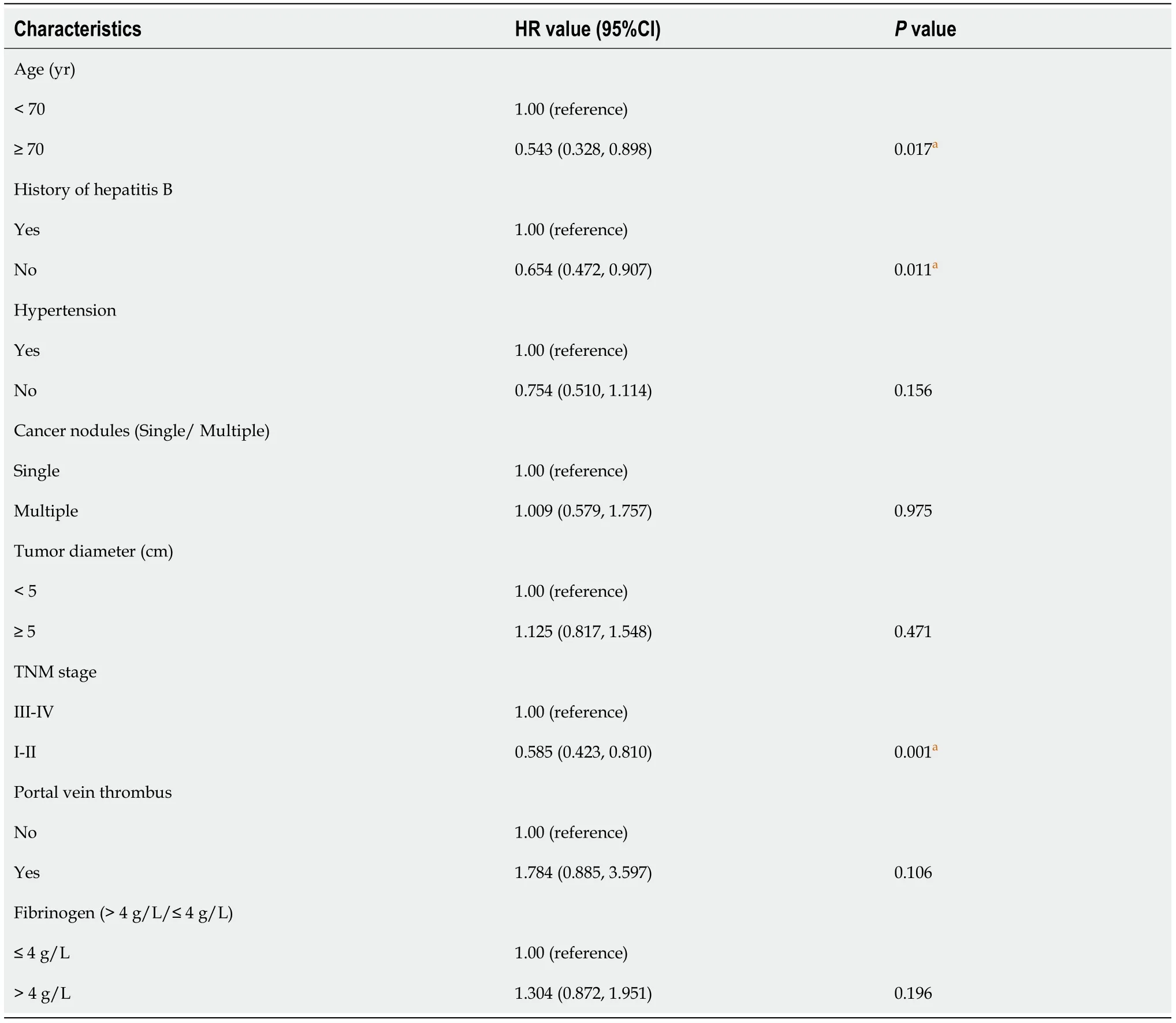
Table 3 Multivariate analysis of different factors associated with disease-free survival in hepatocellular carcinoma patients
DFS results according to different age groups, TNM stage, and hepatitis B history
Young patients had a higher recurrence risk or mortality risk within 6 mo after surgery as a significant downhill trend was seen in these patients in the first 6 mo (Figure 1A). The DFS outcomes in patients who had different TNM stages and a history of hepatitis B are shown in Figures 1B and C, respectively. The median DFS for stages III–IV was 12 mo, and was 68 mo for stages I–II.
To determine the relationship between TNM stage and age, the DFS results are shown in Figure 2A and B. Figure 2A shows that, in stages I-II, patients ≥ 70 years had a longer DFS than those who were < 70 years. However, no discernible differences between stages III-IV were seen. In addition, we revealed an association between age and various TNM stages (Figure 3A and B). According to our results, individuals at stages I and II who were < 70 years had a better prognosis. The relationship between TNM stage and a history of hepatitis B was also examined (Figure 4A and B), but the difference was not statistically significant.
Development and validation of the prediction model
Age, TNM stage, and previous hepatitis B infection were utilized to create a nomogram (Figure 5). The C-index was calculated to be 0.713 (95%CI: 0.660–0.767) using 1000 bootstrap resampling methods, which indicated that the nomogram had a strong level of predictability. The actual survival curve of the nomogram matched closely, based on calibration curves for the 3- and 5-year DFS (Figure 6A and B). We compared the nomogram's receiver operator characteristic against that of the TNM stage to further assess the performance of the model and discovered that the nomogram's area under the curve was greater than that of the TNM stage (Figure 7). The nomogram enhanced the capacity to predict DFS in patients with HCC throughout a large range of risk threshold probabilities, according to the 3- and 5-year decision curve analysis curves (Figure 8A and B).

Figure 2 Kaplan-Meier curves of disease-free survival in different age groups based on tumor node metastasis stage. A: Kaplan-Meier curves of disease-free survival (DFS) in different age groups based on I-II stage; B: Kaplan-Meier curves of DFS in different age groups based on III-IV stage.

Figure 3 Kaplan-Meier curves of disease-free survival in different stage groups based on age. A: Kaplan-Meier curves of disease-free survival(DFS) in different stage groups based on age ≥ 70 years; B: Kaplan-Meier curves of DFS in different stage groups based on age < 70 years.
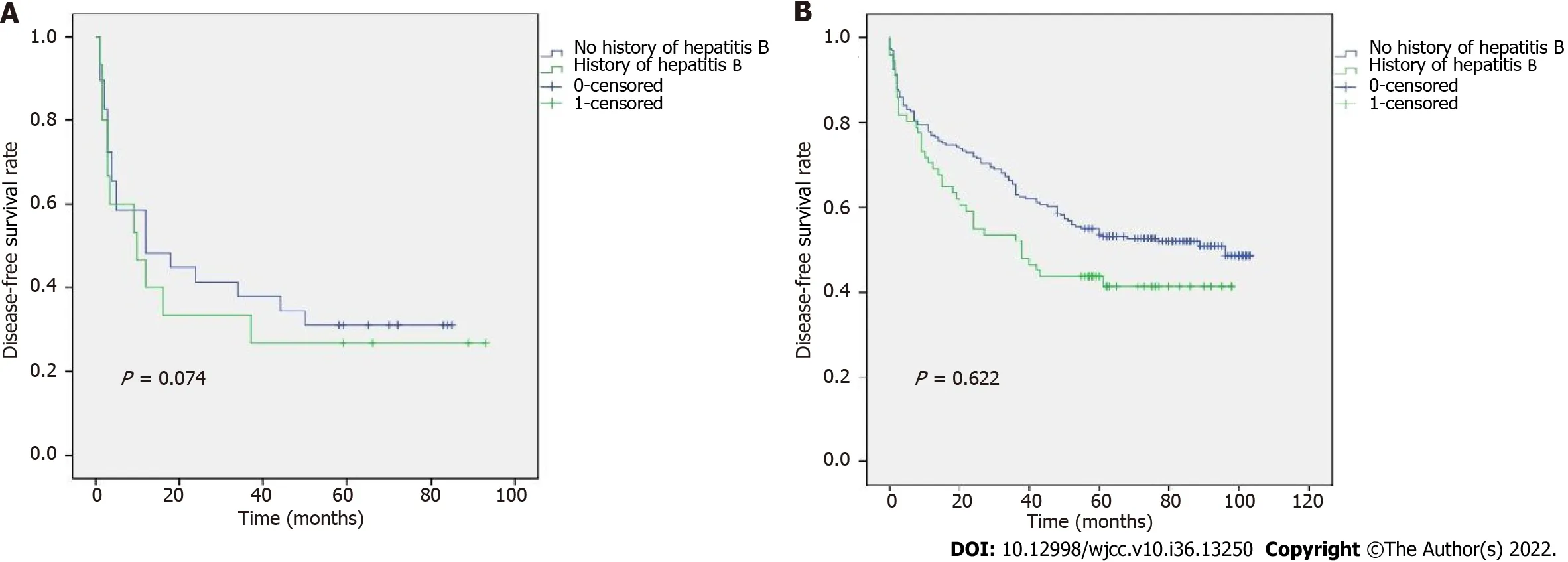
Figure 4 Kaplan-Meier curves of disease-free survival in patients with a different history of hepatitis B based on tumor node metastasis stage. A: Kaplan-Meier curves of disease-free survival (DFS) in groups with a different history of hepatitis B based on I-II stage; B: Kaplan-Meier curves of DFS in groups with a different history of hepatitis B based on III-IV stage.
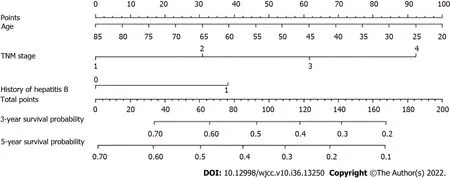
Figure 5 Nomogram for predicting disease-free survival of hepatocellular carcinoma patients after curative resection. TNM: Tumor node metastasis.

Figure 6 Calibration curves of the prognostic nomogram for disease-free survival in hepatocellular carcinoma patients. A: 3-year calibration curves of the prognostic nomogram for disease-free survival (DFS) in hepatocellular carcinoma (HCC) patients; B: 5-year calibration curves of the prognostic nomogram for DFS in HCC patients.
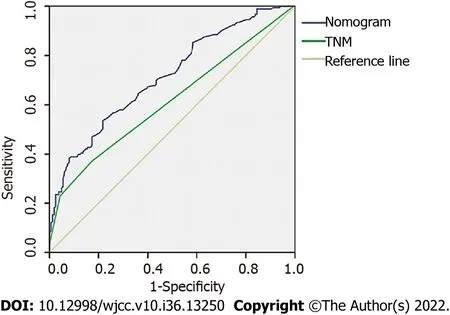
Figure 7 The receiver operator characteristic curves of the prognostic nomogram and tumor node metastasis stage. TNM: Tumor node metastasis.
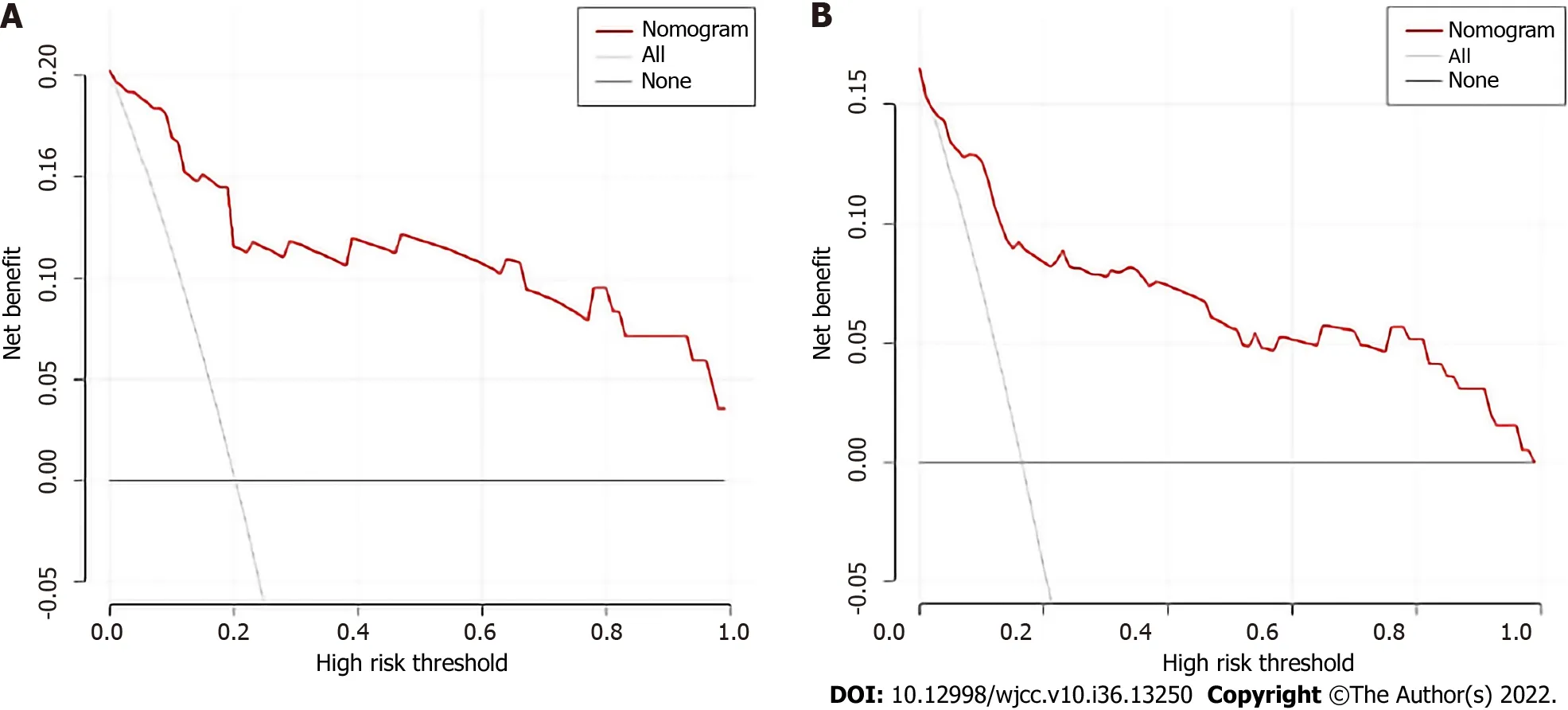
Figure 8 The decision curve analysis curve of the prognostic nomogram for disease-free survival in hepatocellular carcinoma patients. A:3-year decision curve analysis (DCA) curves of the prognostic nomogram for disease-free survival (DFS) in hepatocellular carcinoma (HCC) patients; B: 5-year DCA curves of the prognostic nomogram for DFS in HCC patients.
DISCUSSION
HCC has a high incidence and fatality rate, and increasing attention has been focused on HCC prognostic factors[15,16].
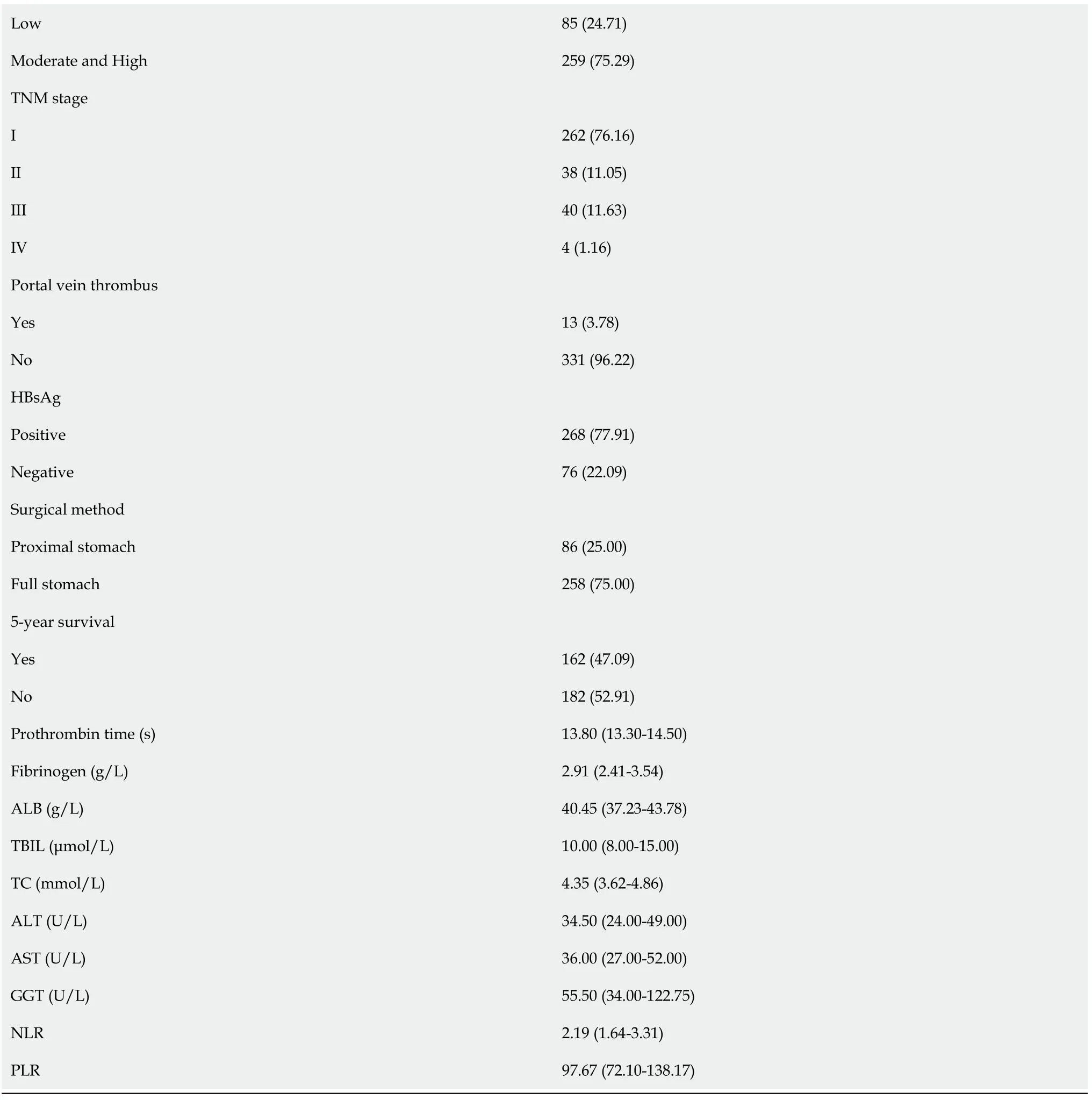
BMI: Body mass index; TNM: Tumor node metastasis; HBsAg: Hepatitis B surface antigen; AFP: Alpha-fetoprotein; ALB: Albumin-bilirubin; TBIL: Total bilirubin; TC: Total cholesterol; AST: Aspartate aminotransferase; ALT: Alanine aminotransferase; GGT: Gamma-glutamyl transpeptidase; NLR: Neutrophil-to-lymphocyte ratio; PLR: Platelet-to-lymphocyte ratio.
Recently, nomograms have been widely used as diagnostic and prognostic tools for various cancers[17]. We attempted to develop a prognostic nomogram that combines most of the important serum markers and clinicopathological characteristics. Many studies have shown that carbohydrate antigen 199 and AFP are related to the OS of patients with HCC[18,19], and the NLR and PLR levels found in the current investigation were similar to earlier results[20,21]. However, we discovered that hematological markers such as NLR, and AFP were not predictive of DFS.
Based on earlier published studies, the elderly group of HCC patients in our study was classified as those ≥ 70 years[22,23]. We examined the DFS of patients aged ≥ 70 and < 70 at TNM stages I-II and IIIIV to further understand how age affects DFS in patients with various TNM stages. Sakakibaraet al[24] used 40 years as the cutoff between young and elderly patients, and found that the 3-year OS of stage IIB patients in the young group was considerably lower than that of the elderly group, which is comparable to our results. Similar findings were obtained by Zhaoet al[25], who retrospectively selected 995 colorectal cancer patients aged 35 years and discovered that they had a poorer prognosis. Faberet al[26], on the other hand, retrospectively examined 141 individuals and reported that those under the age of 35 often had a considerably better prognosis. Regardless of age, we discovered that stages I and II had a more favorable survival than stages III and IV, which is in line with the results of Lu Wuet al[27].
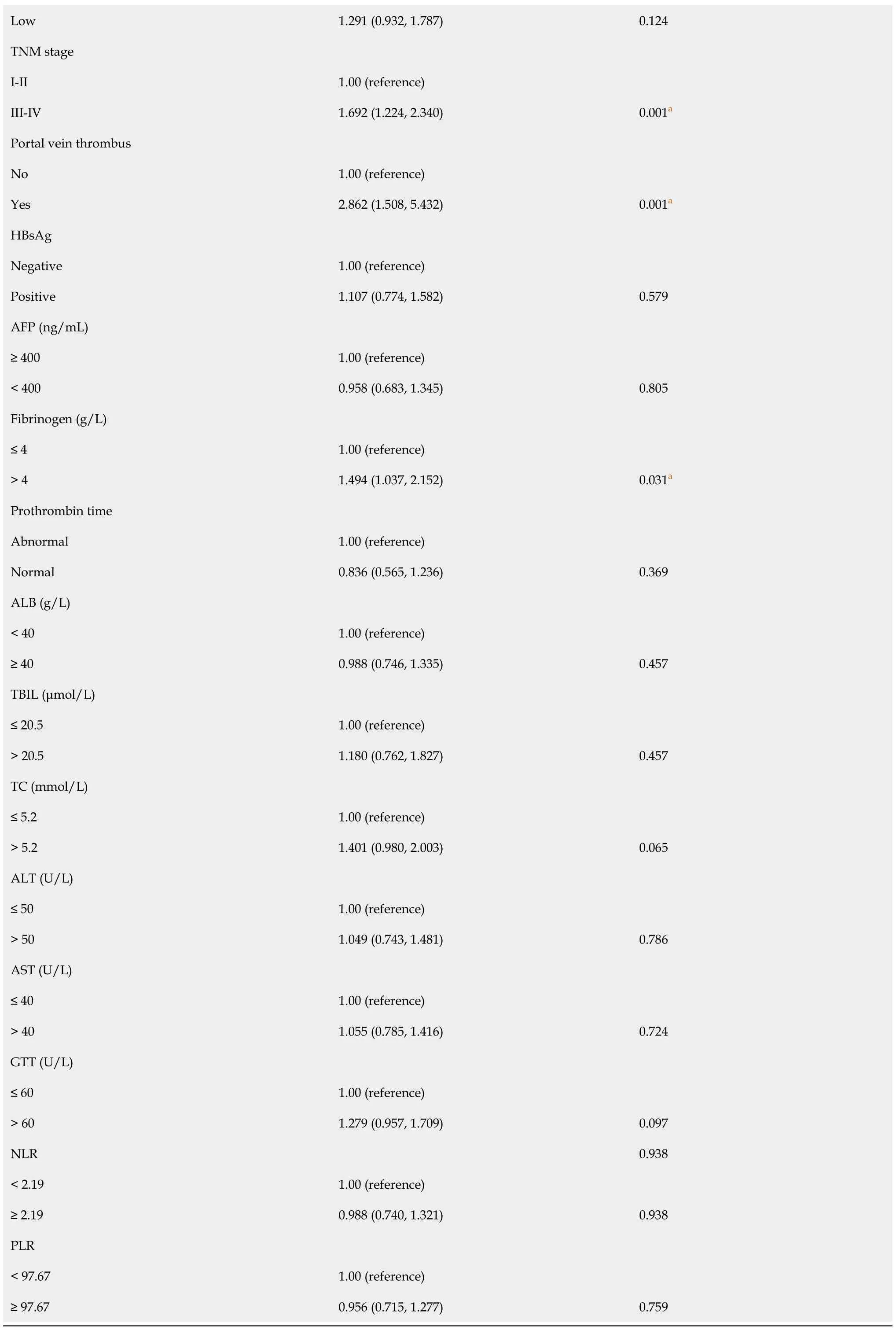
aP < 0.05.BMI: Body mass index; TNM: Tumor node metastasis; HBsAg: Hepatitis B surface antigen; AFP: Alpha-fetoprotein; ALB: Albumin-bilirubin; TBIL: Total bilirubin; TC: Total cholesterol; AST: Aspartate aminotransferase; ALT: Alanine aminotransferase; GGT: Gamma-glutamyl transpeptidase; NLR: Neutrophil-to-lymphocyte ratio; PLR: Platelet-to-lymphocyte ratio.
Hepatitis B virus (HBV), which affects 30% of people globally and is particularly widespread in China[28], is the main culprit in HCC. According to Liet al[29], preoperative HBV DNA levels over 2000 IU/mL were associated with a poorer prognosis and were strongly correlated with OS and DFS. In terms of the pathogenesis of HCC brought on by HBV, the integration of HBV DNA into the host genome triggered changes in gene protrusions, leading to the occurrence of liver cancer. In contrast, HBV-associated proteins, such as HBsAg, hepatitis B core antigen, and HBx, can mediate oxidative stress in cells[30]. Hence, for patients with HCC, more attention should be paid to a history of HBV in clinical practice.
This study had certain limitations, including an insufficient number of elderly patients and was a single center study. A limited relationship was observed between hepatitis B and HCC in Western countries; therefore, this study failed to collect clinical information from more patients (including foreign patients) through the Surveillance, Epidemiology and End Results and other databases to develop a more comprehensive and convincing nomogram model.
CONCLUSION
Age, TNM stage, and a history of hepatitis B infection were independent predictive factors of DFS in HCC patients. We constructed and validated an accurate and reliable nomogram that has great reference value for evaluating the prognosis of patients and guiding treatment.
ARTICLE HIGHLIGHTS
Research background
The most prevalent form of liver cancer is hepatocellular carcinoma (HCC), which also has a poor prognosis and a serious risk of invasion and metastasis.
Research motivation
The First Affiliated Hospital of Anhui Medical University treated 445 HCC patients with curative hepatectomy.
Research objectives
The objective of this study was to develop a valid nomogram and explore the independent prognostic markers for disease-free survival (DFS) in HCC patients.
Research methods
A survival curve was plotted using the Kaplan–Meier method and tested using the log-rank method. To identify the prognostic variables, multivariate Cox regression analysis was carried out. To predict DFS in patients with HCC, a nomogram was created. C-indices and receiver operator characteristic curves were used to evaluate the nomogram's performance. Decision curve analysis (DCA) was used to evaluate the clinical application value of the nomogram.
Research results
A longer DFS was observed in patients with the following characteristics: Elderly, I-II stage, and no history of hepatitis B. The calibration curve showed that this nomogram was reliable and had a higher area under the curve value than the tumor node metastasis stage. Moreover, the DCA curve revealed that the nomogram had good clinical applicability in predicting 3- and 5-year DFS in HCC patients after surgery.
Research conclusions
We created and tested a new nomogram to predict DFS in HCC patients, which was accurate and reliable.
Research perspectives
We constructed and validated an accurate and reliable nomogram that has great reference value for evaluating the prognosis of patients and guiding treatment.
FOOTNOTES
Author contributions:Pan-Quan Luo, Zheng-Hui Ye and Li-Xiang Zhang. Luo PQ, Ye ZH and Zhang LX contribute equally to this manuscript. Luo PQ collected the patients’ clinical information, performed the statistical analysis, and completed writing of the manuscript; Ye ZH and Zhang LX assisted in collecting the patients’ clinical information and writing the manuscript; Song ED helped them.; Lu Z, Xu AM and Wei ZJ designed the main study and critically revised the manuscript; All authors read and approved the final manuscript.
Supported byResearch Fund Project of Anhui Institute of Translational Medicine, No. 2021zhyx-C54; Foundation of Anhui Medical University, No. 2019xkj146; and National and Provincial Key Specialty Construction Plan, No. Z155080000004.
Institutional review board statement:The present study was reviewed and approved by Ethics Committee of The First Hospital of Anhui Medical University (Approval No. PJ 2022-12-11).
Informed consent statement:Patients were not required to give informed consent for this study as the analysis used anonymous clinical data that were obtained after each patient agreed to treatment by written consent.
Conflict-of-interest statement:All the authors report no relevant conflicts of interest for this article.
Data sharing statement:The data used and/or analyzed during the current study were obtained from the Department of Gastrointestinal Surgery, the First Hospital of Anhui University. The data are available from the corresponding author on reasonable request.
Open-Access:This article is an open-access article that was selected by an in-house editor and fully peer-reviewed by external reviewers. It is distributed in accordance with the Creative Commons Attribution NonCommercial (CC BYNC 4.0) license, which permits others to distribute, remix, adapt, build upon this work non-commercially, and license their derivative works on different terms, provided the original work is properly cited and the use is noncommercial. See: https://creativecommons.org/Licenses/by-nc/4.0/
Country/Territory of origin:China
ORCID number:Pan-Quan Luo 0000-0002-4060-4576; Li-Xiang Zhang 0000-0002-6288-1400; Zhi-Jian Wei 0000-0003-1094-1894; Zhen Lu 0000-0001-6641-9910.
S-Editor:Liu GL
L-Editor:Webster JR
P-Editor:Liu GL
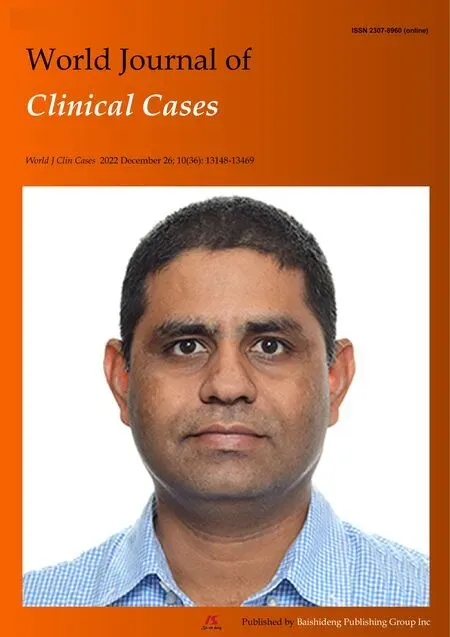 World Journal of Clinical Cases2022年36期
World Journal of Clinical Cases2022年36期
- World Journal of Clinical Cases的其它文章
- Liver injury in COVID-19: Holds ferritinophagy-mediated ferroptosis accountable
- Amebic liver abscess by Entamoeba histolytica
- Living with liver disease in the era of COVID-19-the impact of the epidemic and the threat to high-risk populations
- Cortical bone trajectory screws in the treatment of lumbar degenerative disc disease in patients with osteoporosis
- Probiotics for preventing gestational diabetes in overweight or obese pregnant women: A review
- Effectiveness of microwave endometrial ablation combined with hysteroscopic transcervical resection in treating submucous uterine myomas
